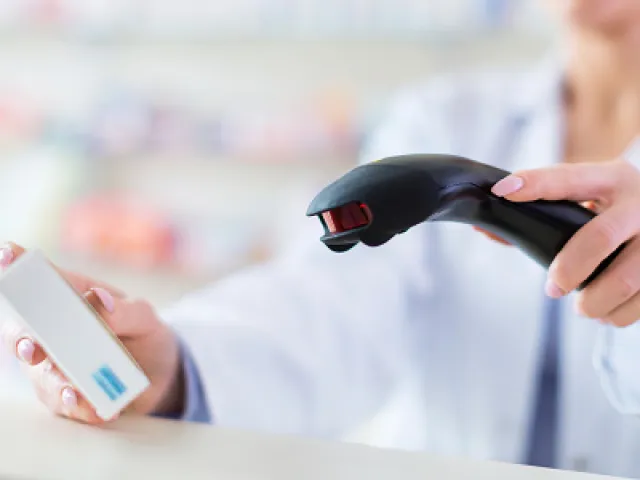Table of contents
Key DSCSA guidance takeaways
- Dispensers (health systems and retail pharmacies) will be responsible for meeting FDA verification and notification requirements regarding suspect or illegitimate products by November 2023.
- Pharmacies need to develop solutions and procedures that enable staff to identify “suspect product” and determine if it is illegitimate.
- The FDA has provided DSCSA guidance for the industry on how it defines “enhanced systems and processes” for verification of products at the individual package level.
What are the basic provisions of “DSCSA 2023?”
The final phase of the Drug Supply Chain Security Act, also known as “DSCSA 2023,” will require a full-scale effort over the next 24 months to ensure that health systems and pharmacies can meet DSCSA requirements for 100% digital data exchange to verify the legitimacy of drugs and ensure patient safety. The major provisions of the DSCSA apply to manufacturers, repackagers, wholesale distributors, and dispensers and include:
- Product identification: The addition of a unique product identifier on certain prescription drug packages.
- Product tracing: The ability to provide information about a drug and who handled it each time it is sold in the U.S. market.
- Product verification: Establishing systems and processes to verify the product identifier on certain prescription drug packages.
- Detection and response: The quarantine and prompt investigation of a drug that has been identified as suspect, meaning that it may be counterfeit, unapproved, or potentially dangerous.
- Notification: Establishing systems and processes to notify the FDA and other stakeholders if an illegitimate drug is found.
Detection and response: Identifying “suspect product”
For dispensers, the ability to detect a potentially illegitimate product—and initiate the appropriate action—will be critical in meeting DSCSA requirements. According to the DSCSA, the term “suspect product” means there is reason to believe that such product:
- Is potentially counterfeit, diverted, or stolen.
- Is potentially intentionally adulterated such that the product would result in serious adverse health consequences or death to humans.
- Is potentially the subject of a fraudulent transaction.
- Appears otherwise unfit for distribution such that the product would result in serious adverse health consequences or death to humans.
While the statutory text of the DSCSA simply refers to the terms “counterfeit, diverted, or stolen,” recent guidance from the United States Food and Drug Administration provides more detailed definitions to help companies develop systems and processes for detecting and responding to a product which is deemed suspect:
Counterfeit. A drug which—or the container or labeling of which, without authorization—bears the trademark, trade name, or other identifying mark, imprint, or device, or any likeness thereof, of a drug manufacturer, processor, packer, or distributor other than the person or persons who in fact manufactured, processed, packed, or distributed such drug and which thereby falsely purports or is represented to be the product of—or to have been packed or distributed by—such other drug manufacturer, processor, packer, or distributor.
Diverted. In reference to suspect or illegitimate product, and the verification and notification obligations of dispensers, FDA interprets the term diverted to refer to a:
- Product that left the U.S. pharmaceutical distribution supply chain and is reintroduced in the United States in a transaction with a trading partner. For example, this would include product that is dispensed to a consumer or patient and then reintroduced into the U.S. pharmaceutical distribution supply chain to a trading partner; or
- Product that is labeled for sale in a non-U.S. market and that is introduced into the U.S. pharmaceutical distribution supply chain through a transaction with a trading partner.
A product would not be considered diverted as described above and, therefore, would generally not be considered a suspect or illegitimate product under DSCSA, solely if a trading partner obtains that drug product:
- Through surveillance activities outside the U.S. pharmaceutical distribution supply chain;
- From a consumer or patient who obtained the product from outside the U.S. pharmaceutical distribution supply chain;
- Obtained as a result of FDA’s regulatory action to address a drug shortage; or
- Where an Emergency Use Authorization has been issued.
Stolen. For purposes of the verification obligations (including notification) in section 582 of the DSCSA, FDA interprets the term stolen as it applies to a package of product to refer to:
- Any product in its entirety (the prescription drug and its packaging) that has been taken or removed without permission of the owner of the product. For example, a bottle and all of its content of drug are taken or removed from the trading partner, or product taken as the result of cargo theft, warehouse theft, or courier theft.
- Any packaging of a product that has been taken or removed without the permission of the owner. For example, only the empty bottle or outer carton is taken or removed from the trading partner.
- Any prescription drug that has been taken or removed without permission of the owner of the product, For example, all or some of the tablets are removed from a bottle and then taken or removed from the trading partner.
- Any prescription drug and/or its packaging, in physical custody of a trading partner, that is missing all or any portion of the drug as a result of the drug being taken or removed without permission of the owner. For example, half of the tablets are removed from a bottle and the bottle with the remaining tablets is left with the trading partner subject to the theft, or all the tablets are removed from the bottle and the bottle is left with the trading partner subject to the theft.
What is a “fraudulent transaction?”
In reference to suspect or illegitimate product, and the verification obligations (including notification) of dispensers, FDA interprets the term fraudulent transaction as referring to a transaction in which the transaction information, transaction history, or transaction statement contains information knowingly falsified by a trading partner who has provided or received the information.
Note that transaction histories, required for lot-level tracing prescription medicines since 2015, will be eliminated and replaced by all-electronic transaction information and statements for tracing products at the package level in 2023.
When is a product considered “unfit for distribution?”
For purposes of the verification and notification obligations for dispensers in section 582 of the DSCSA, FDA interprets the term unfit for distribution as referring to a prescription drug whose sale would violate the Food, Drug, and Cosmetic Act and there is a reason to believe or credible evidence shows that the product would be reasonably likely to result in serious adverse health consequences or death to humans. This includes prescription drugs identified as suspect or illegitimate; adulterated, including drugs rendered non-saleable because conditions (such as return, recall, damage, or expiry) cast doubt on the drug’s safety, identity, strength, quality, or purity; or misbranded where there is a reason to believe or credible evidence shows that such product would be reasonably likely to result in serious adverse health consequences or death to humans.
This definition of "unfit for distribution," used to determine whether a product could be considered suspect or illegitimate, does not include a product that is awaiting reverse distribution and processing and will not be distributed to patients. Similarly, a product granted a waiver, exception, or exemption or grandfathered under section 582 of the DSCSA could be unfit for distribution because it otherwise falls under the definition laid out in this section.
Are you ready for “all-digital” DSCSA traceability requirements?
The FDA's DSCSA guidance signals the start of an industry-wide, cross-segment push to achieve “all digital” data exchange required by DSCSA by November 2023. For dispensers, the complexity of item-level traceability requires early planning and budgeting to ensure a smooth transition and to minimize any disruption to pharmacy operations.
Contact us to learn how TraceLink can help you meet your DSCSA 2023 compliance requirements.









